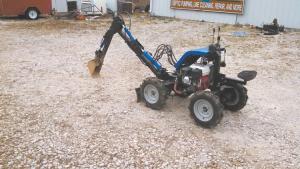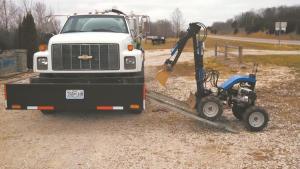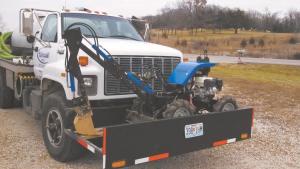Mini Backhoe Replaces Back-Breaking Shovel Work
Trinity Kincaid nicknamed his mini-backhoe “MyShovel” because of its ability to handle jobs large and small in Missouri hill country. It replaced a lot of hand digging, which he did plenty of while running his rural septic service.
“I live and work at Lake of the Ozarks, and the soil is clay and rock,” he says. “I used to use a pick axe or bar to break clods loose. I even bought a small jackhammer.”
Kincaid considered buying a small excavator, but he worried about finding parts for the limited production machines. He finally decided to build his own.
“I found plans for a towable backhoe on the internet and modified it,” says Kincaid. “I wanted one that was self-propelled, but could get into tight spots and wouldn’t require a trailer.”
Kincaid based his backhoe boom on plans from www.thegreensmachines.com. He used 1/4-in. steel plate for flat stock and 0.188 thick, 2 1/2-in. square tubing for the boom arms and chassis. The bucket is 7 in. wide with teeth cut from leaf springs. Kincaid bought the metal and had it cut and sheared locally.
“Everything from the boom back is mine, including the swivel,” he says.
The motor sits on an I-shaped chassis made from 2 1/2-in. tubing with 1/4-in. plate gussets. A set of hydraulic drive wheels is mounted at either end. Two vertical tubes are mounted to the rear of the chassis. The forward one serves as a mount for control valves while the one to the rear is a mount for a removable seat.
At the front of the chassis, the boom and its hydraulic cylinder are mounted to a yoke and swivel plate fabricated from 4 pieces of 3 by 5-in., 1/2-in. thick angle iron.
“I slipped them together and bolted them in place to be sure everything dovetailed together and slid and locked like needed,” says Kincaid. “Only then did I weld it together.”
A hydraulic cylinder extends from the chassis center frame to an offset mount on the swivel plate, swinging the boom to the left or right. Another short cylinder mounted to the front of the chassis raises and lowers a short blade he picked up at a garage sale. It works in lieu of outriggers.
“A 5 hp Honda with a love joint to a 2 gpm hydraulic pump supplies power to the backhoe valve body and the drive wheels,” says Kincaid. “The wheels on each side run in series, so fluid goes to the first wheel and then to the second and then to the valve. It’s like a liquid chain.”
Kincaid explains that if the wheels were moving at a high speed, one would be turning faster than the other. However, at low speeds the second wheel is providing about 200 percent traction.
Kincaid considered building a small trailer to tow the backhoe to job sites. Instead he decided to mount it on the front end of his truck. He extended the frame about 3 ft., providing more than enough space for the 32-in. wide backhoe.
When he gets to the job site, he backs it off the carrier, puts the seat in place and drives it to the site of the septic tank. When the dirt is removed, he also uses the bucket to pick up lids, which can weigh as much as 180 lbs.
“You can do quite a bit with it if you’re patient, “ he says.
What it can’t do is easily break through a pipe, which Kincaid appreciates. “You’ll feel the pull on the machine before it can hurt a pipe,” he says.
Kincaid estimates it took him 6 mo. to build the machine, initially with 2-WD. It took another week to make it 4-WD. Plans, steel, hydraulic hoses, cylinders, engine and other components totaled about $4,000.
Buying local and looking for deals kept costs down. “I found the wheel motors on sale for $200 each,” he recalls. “Normally they were priced at $600. I paid only $16 each for the wheel hubs at a surplus center, but the regular price was $100 each.”
Kincaid is more than satisfied with the investment. He has a boom that swings out with a reach of about 6 ft. and a maximum depth of about 4 ft. Each bucket is equivalent to about 3 spades full of dirt.
“I can move a cubic yard of dirt in about 20 min.,” says Kincaid. “By hand, it would take about 2 hrs.”
Contact: FARM SHOW Followup, Trinity Kincaid, Kincaid Septic, 22752 Hwy. 5, Versailles Mo. 65084 (ph 573 216-7867; tk.kincaidseptic@gmail.com).

Click here to download page story appeared in.
Click here to read entire issue
Mini Backhoe Replaces Back-Breaking Shovel Work FENCING Miscellaneous Trinity Kincaid nicknamed his mini-backhoe “MyShovel” because of its ability to handle jobs large and small in Missouri hill country It replaced a lot of hand digging which he did plenty of while running his rural septic service “I live and work at Lake of the Ozarks and the soil is clay and rock ” he says “I used to use a pick axe or bar to break clods loose I even bought a small jackhammer ” Kincaid considered buying a small excavator but he worried about finding parts for the limited production machines He finally decided to build his own “I found plans for a towable backhoe on the internet and modified it ” says Kincaid “I wanted one that was self-propelled but could get into tight spots and wouldn’t require a trailer ” Kincaid based his backhoe boom on plans from www thegreensmachines com He used 1/4-in steel plate for flat stock and 0 188 thick 2 1/2-in square tubing for the boom arms and chassis The bucket is 7 in wide with teeth cut from leaf springs Kincaid bought the metal and had it cut and sheared locally “Everything from the boom back is mine including the swivel ” he says The motor sits on an I-shaped chassis made from 2 1/2-in tubing with 1/4-in plate gussets A set of hydraulic drive wheels is mounted at either end Two vertical tubes are mounted to the rear of the chassis The forward one serves as a mount for control valves while the one to the rear is a mount for a removable seat At the front of the chassis the boom and its hydraulic cylinder are mounted to a yoke and swivel plate fabricated from 4 pieces of 3 by 5-in 1/2-in thick angle iron “I slipped them together and bolted them in place to be sure everything dovetailed together and slid and locked like needed ” says Kincaid “Only then did I weld it together ” A hydraulic cylinder extends from the chassis center frame to an offset mount on the swivel plate swinging the boom to the left or right Another short cylinder mounted to the front of the chassis raises and lowers a short blade he picked up at a garage sale It works in lieu of outriggers “A 5 hp Honda with a love joint to a 2 gpm hydraulic pump supplies power to the backhoe valve body and the drive wheels ” says Kincaid “The wheels on each side run in series so fluid goes to the first wheel and then to the second and then to the valve It’s like a liquid chain ” Kincaid explains that if the wheels were moving at a high speed one would be turning faster than the other However at low speeds the second wheel is providing about 200 percent traction Kincaid considered building a small trailer to tow the backhoe to job sites Instead he decided to mount it on the front end of his truck He extended the frame about 3 ft providing more than enough space for the 32-in wide backhoe When he gets to the job site he backs it off the carrier puts the seat in place and drives it to the site of the septic tank When the dirt is removed he also uses the bucket to pick up lids which can weigh as much as 180 lbs “You can do quite a bit with it if you’re patient “ he says What it can’t do is easily break through a pipe which Kincaid appreciates “You’ll feel the pull on the machine before it can hurt a pipe ” he says Kincaid estimates it took him 6 mo to build the machine initially with 2-WD It took another week to make it 4-WD Plans steel hydraulic hoses cylinders engine and other components totaled about $4 000 Buying local and looking for deals kept costs down “I found the wheel motors on sale for $200 each ” he recalls “Normally they were priced at $600 I paid only $16 each for the wheel hubs at a surplus center but the regular price was $100 each ” Kincaid is more than satisfied with the investment He has a boom that swings out with a reach of about 6 ft and a maximum depth of about 4 ft Each bucket is equivalent to about 3 spades full of dirt “I can move a cubic yard of dirt in about 20 min ” says Kincaid “By hand it would take about 2 hrs ” Contact: FARM SHOW Followup Trinity Kincaid Kincaid Septic 22752 Hwy 5 Versailles Mo 65084 ph 573 216-7867; tk kincaidseptic@gmail com









